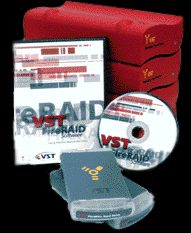
Make Your
FireWire Drives Shoot Flames With
FireRAID
from
SmartDisk/VST!

Make Your FireWire Drives Shoot Flames With
FireRAID from SmartDisk/VST!
Posted
12/7/2000
© 2000 Rob Art Morgan, chief rocket scientist at BARE FEATS
rob-art@barefeats.com
I've been disappointed with the speed of FireWire drives. Though the fastest Ultra ATA/100 drive is used by the best manufacturers, the sustained write speed is a sorry 13MB/sec. Connect the same drive to an Ultra ATA controller and the write speed jumps to over 30MB/sec.Although you can expect faster FireWire drives to be introduced in the near future, you don't have to wait a second longer. Thanks the new FireRAID software from SmartDisk/VST, you can create a striped array (RAID level 0) with two or more FireWire drives. You can also create a mirrored array (RAID level 1).
I tested using the SmartDisk/VST Full Height FireWire drives (45GB). I created striped arrays using dual drives and quadruple drives. I tested using daisy chaining as well as multi-channels.
Multi-channels? Yes. It occurred to me that even though the G3 and G4 minitowers have 3 FireWire ports, they run off of a single chip. That constitutes ONE channel. By adding a VST FireWire PCI card, I was able to create TWO channels. Kaboom!
SUSTAINED READ/WRITE
Here's the first test I run to get a flavor of speed potential...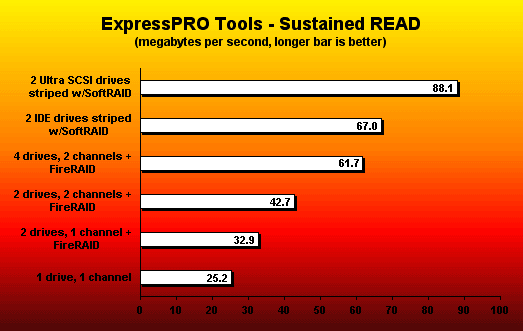
RANDOM READ/WRITE
Sustained speed is key to multimedia applications but most users should be concerned about random disk activity...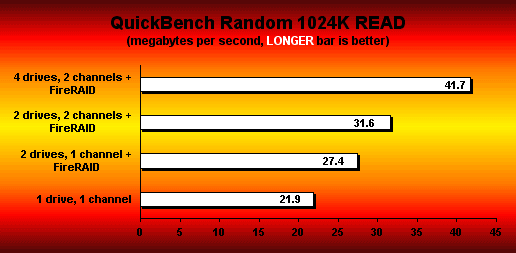
FINDER DUPLICATE TESTS
Duplicating files on the test drive is a great test since it forces it to read and write to itself simultaneously...
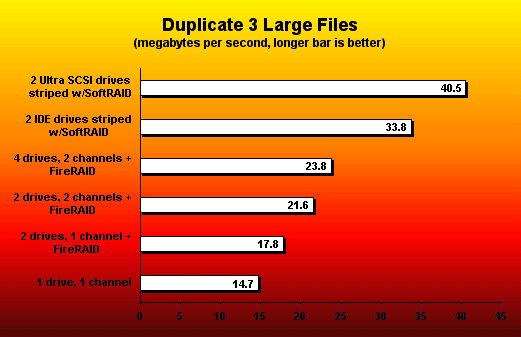
QUICKTIME PLAYBACK
I playback ALL frames of a 5.5 second, full screen, uncompressed QuickTime movie (176.7MB document) as fast as possible. If the drive kept up with "real time," it would clock 32MB/sec. Unless a drive achieves that, you must consider using some kind of compression scheme.
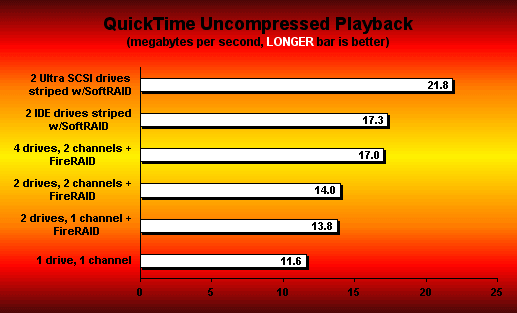
2. FireRAID gives you a low cost FireWire RAID solution. To get a faster FireWire RAID than the configurations I tested, you would have to spend $3700 to $4500 on VST's FireWire RAID array.
3. If you have MULTIPLE FireWire channels, you can increase your speed even more. I made dual channels by putting half of my striped array on a VST FireWire/USB Combo card and half on the built-in FireWire ports.
Wouldn't it be great if Apple offered dual channel FireWire on the next generation of G4 desktop? Wouldn't it be hot if someone offered a multi-channel FireWire PCI card? After all, dual channel SCSI cards are common. And at least one company has announced a dual channel Ultra ATA/100 PCI card.
If you have a PowerBook 2000, you can create a second channel by using a CardBus FireWire card in addition to the built-in FireWire. Even if you don't need FireRAID, having dual channels could solve some of the problems reported by users who tried to hook a digital camera and FireWire drive to the same built-in channel.
4. Reality check. Even with the help of FireRAID, the Ultra160 and Ultra ATA/66 dual drive arrays outperformed the FireWire arrays. But if you need hot swappable, external drive arrays, then FireRAID is the only way to fly.
WHERE TO BUY
FireRAID is available from SmartDisk/VST Technology direct for a $99.95. If you buy it with one of their drives, the price drops to $49.95. Buy two drives and you get it for $24.95.
CAUTION: before you buy FireRAID, be advised that it is designed to work only with VST FireWire drives.
While you are at VST's site, check out their prices on VST 3.5 inch FireWire drives, 2.5 inch FireWire drives, FireWire/USB Combo PCI card and FireWire CardBus card.
VST products are also available from many E-sellers including Buy.com, MacGurus, Onvia.com, Other World Computing, and Outpost.com.
ONE POSSIBLE ALTERNATIVE FIREWIRE RAID REALITY
According to Intech Software, their 3.1.1 version of Hard Disk SpeedTools supports RAID level 0. They call it QuickStripe. But there are three catches:
1. You must use a FireWire drive that uses an Indigita bridge board.
2. You need the SIM extensions from Indigita. As of this writing, they are not available on the Indigita site.
3. It only supports RAID level 0 (striping) and then only on two drives. VST's FireRAID supports RAID level 1 (mirroring) and any number of drives. I've used it with 6 drives.
TEST CONFIGURATION AND PROCEDURES
TEST MACHINE: An Apple G4/400 Sawtooth and 512MB of "222" PC-100 memory. Mac OS 9.04, VM off, ATALK off, clock display off, minimal extensions. Disk cache set to 128K (minimum setting).
HARD DRIVE SCENARIOS
1. Adaptec 39160 PCI controller with dual Quantum Atlas V 7200rpm drives and Adaptec SoftRAID (version 2.2.2)
2. VST UltraTek/66 Ultra ATA/66 PCI controller with dual IBM 75GXP 7200rpm 45GB drives and Adaptec SoftRAID.
3. VST FireWire/USB Combo PCI controller and built-in FireWire controller driving either two or four VST FireWire full height 45GB drives with VST FireRAID.
4. Built-in FireWire controller driving a single VST FireWire full height 45GB drive using VST's FireWire driver.SUSTAINED READ/WRITE
The sustained read/write benchmark was run using Express-Pro Tools 2.3.2 benchmark test with 2MB maximum file size and system disk cache disabled. Sustained Rate is displayed in the charts.RANDOM READ/WRITE
Intech's Hard Disk Speed Tools 3.1.1 include SpeedBench 1.5. It's a great gauge of the random read/write speed. Although you can choose various block sizes from 1K to 1024K, I chose to display the 1024K results.THE FILE DUPLICATION
For the DUPLICATE THREE BIG DOCS test, I copied a 27MB Adobe Photoshop document onto each drive and made three copies. Then I timed how long it took to duplicate the THREE copies of the photo (81MB total) on the same drive. That's a simultaneous read/write of 3 large files. The "megabytes per second" was calculated using the formula M=size/time * 2.For the DUPLICATE LOTZA DOCS, I copied the Unreal Tournament 425a folder (101MB, 265 files) onto the drive and duplicated it. The "megabytes per second" was calculated using the formula M=size/time * 2.
THE QUICKTIME PLAYBACK
Thanks to a reader named Alex, I was able to use a 5.5 second segment (176.7MB) of a full screen, uncompressed QuickTime movie he created. I set it to play ALL frames as fast as possible. Using a stopwatch, the playback is timed to the nearest tenth of a second. Since I know the exact size of the document, I calculated the "megs per second" playback rate. If all frames actually played in "Real Time," the rate would be 32MB/sec.
© 2000 Rob Art Morgan, publisher of BARE FEATS